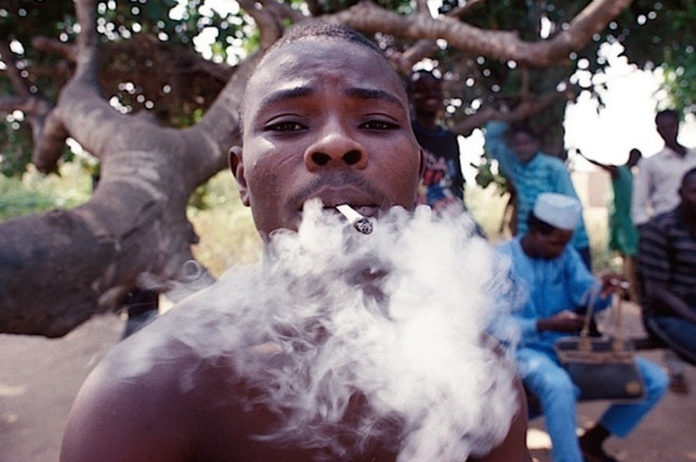Tobacco growing and manufacturing was introduced in the 1920 by British American Tobacco (BAT) and Uganda has since been established as a country of significant importance in driving the tobacco industry in East Africa.
The 2015 World Health Organization STEPwise approach to surveillance (STEPS) survey estimated the prevalence of smoking in adults to be 16.7% in men and 3.4% in women.Results from the 2011 Global Youth Tobacco Survey (the most recent available) suggest that amongst young people (13-15 year-olds), 19.3% of young men and 15.8% of young women use tobacco.
Tobacco leaf production in Uganda increased significantly after 2006, when BAT established Uganda as the hub of its Leaf Operations in Eastern Europe, Middle East and Africa (EEMEA), supplying 20 countries worldwide.The export of tobacco leaf has since grown significantly, from USD 26,964,000 in 2006 to USD 58,256,000 in 2012, as reported by the Food and Agriculture Organisation of the United Nations.
The number of farmers growing tobacco crop has also risen over the same period. According to the Ministry of Agriculture, Animal Industry and Fisheries, there were an estimated 75,000 farmers relying on the crop by 2014.However, late in 2014 BAT Uganda announced it would no longer grow tobacco leaf in Uganda, and Alliance One International (an international tobacco leaf merchant) stated it would take over BAT’s leaf operations.At the time, BAT was reported in the Ugandan press to be responsible for 70% of Uganda’s tobacco leaf production.
In 2017, British American Tobacco Uganda accounted for 44% of overall volume sales in the Uganda tobacco cigarette market. BAT Uganda’s main competitor in the market is Continental Tobacco Uganda (a subsidiary of Kenyan owned Mastermind Tobacco Kenya).
Historically there are a number of laws that have regulated aspects of tobacco control in Uganda, namely: The Tobacco (Control and Marketing) Act (1967), Public Health Act (1964), Constitution of the Republic of Uganda (1995), National Environment Act (1996), and the National Environment Regulations (2004).
Uganda signed the World Health Organization’s Framework Convention on Tobacco Control (FCTC) in 2005 and ratified the treaty in June 2007.The regulations listed above failed to comply with the FCTC. In an effort to safeguard public health and regulate the tobacco industry in Uganda, the Ministry of Health began drafting the country’s first dedicated tobacco control law, the Uganda Tobacco Control Bill (UCTB).
The UTCB (now the Uganda Tobacco Control Act 2015) was first tabled in Parliament by Hon. Chris Baryomonsi in December 2011 as a private members bill.The progressive Bill sought to “regulate the manufacture, sale, labelling, promotion, advertising, distribution, public use of tobacco products, and sponsoring of tobacco products”. In March 2014, the Bill was presented for its first reading and was subsequently referred to the Parliamentary Committee on Health for further revisions and consultation. In July 2015, 15 months after its first reading and after intense pressure from the tobacco control community to oppose many instances of tobacco industry interference, the Bill was finally presented for its second reading in Parliament by Hon. Rosemary Nyakikongoro.
The UTCB was finally passed in the Ugandan Parliament on its third reading on the 28th July 2015,eight years after Uganda ratified the FCTC. The Bill’s provisions for tobacco control were considered to be the strongest in Africa at the time of passage,and include:
- 100% smoke-free public places;
- pictorial health warnings, covering 65% of the pack to inform the public of the dangers of tobacco;
- prohibiting tobacco industry interference;
- a ban on the sale of cigarettes to and by persons less than 21 years;
- a ban on smoking within a distance of 50 meters of any public place (including shisha, electronic cigarettes and chewing tobacco products);
- ban on tobacco advertising, promotion and sponsorship (TAPS);
- requirements that cigarette packs “shall not prominently display” at point-of-sale.
On the 19 September 2015, the Bill- now the Tobacco Control Act 2015- was assented and signed by President Museveni.
Uganda’s commitment to tobacco control has been meet with consistent opposition from the tobacco industry; industry tactics to undermine the Tobacco Control Act have included: “blackmailing” politicians,employing front groups and third parties to further the industry agenda, violating the FCTC Article 5.3 by directly engaging politicians and influencing policymaking through trade committees and farmers organisations.
In November 2016, BAT Uganda launched legal action against the government challenging the Tobacco Control Act of 2015.The petition, submitted to the Constitutional Court in Kampala, contended that the Tobacco Control Act had the effect of unjustifiably singling out the tobacco industry for discriminative treatment and contravened Articles 40(2), 26 and 29(1) of the Constitution of the Republic of Uganda.In May 2019, the Court upheld the 2015 Tobacco Control Act as constitutional, dismissing the petition and rejecting this legal challenge.
Justice Kenneth Kakuru said in his judgment:
“…legislations like the Tobacco Control Act that seeks to protect the public from the adverse effects of the petitioner’s products (tobacco) cannot be said to be unconstitutional.”
However, more needs to be done to completely get rid of tobacco in the country.
“This material is reproduced from www.TobaccoTactics.org. Copyright University of Bath and used under permission of the University of Bath. All rights reserved.”

















